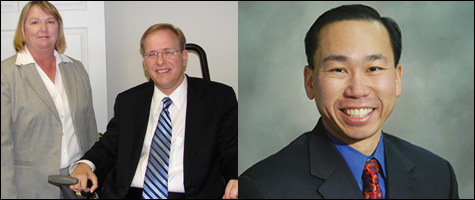
HISTORIC BATTLE: Voters will elect either Rhode Island’s first Asian-American mayor or Cranston’s
first female mayor. |
Without Laffey, it’s just not as fun.
In his four years in office, the businessman-turned-mayor redefined Cranston politics, and to a great extent, set a new tone for Republicans in Rhode Island politics. He was char-ismatic, outspoken, with a caustic wit and a love of drama and grand gestures.
The strength of his persona almost forced you to choose: love him or hate him.
Allan W. Fung chose to support Stephen J. Laffey, and it paid off. His well-organized political machine — complete with color-coordinated blue and yellow signs — helped Fung win an at-large seat on the City Council and reelection two years later.
As Laffey’s strongest backer on the council, Fung also benefited from the mayor’s popularity and clout. When Laffey decided to run for US Senate, Fung was his natural suc-cessor.
Cynthia M. Fogarty, on the other hand, was a vocal critic of Laffey, especially of his fights with labor and with the schools. Like Fung, she was in a high-profile position to run for mayor in 2006. But while Fung got his party’s backing, the Democratic machine overwhelmingly preferred Fogarty’s rival, Michael T. Napolitano, a former municipal court judge. He beat her resoundingly in a primary, and went on to beat Fung — but by only 79 votes.
Now there’s a rematch, but the drama is gone. Laffey is nowhere in sight, and the only vestige of his political powerhouse is Fung’s blue and yellow campaign color scheme.
Both candidates are generally well-liked, but Fung — who is on leave from his job as a lobbyist for MetLife Auto & Home — is widely viewed as the frontrunner, both because he came so close once before, and because he’s been raising money and campaigning since the last election.
Napolitano’s unpopularity also helps Fung. In June, a private poll commissioned by state Representative Peter G. Palumbo (D-Cranston), showed 51 percent of local voters fa-vored Fung, while 31 percent liked Napolitano. Soon after, the mayor said he wouldn’t seek re-election.
After two other Democrats, Councilwoman Paula McFarland and state Representative Charlene Lima, chose not to run, Fogarty stepped in. But she started at zero, whereas on July 1, campaign finance reports show, Fung had $71,328, and he’d spent $15,601 in the preceding three months.
By October 6, the latest reporting deadline, Fogarty had raised $47,295, $30,000 of it in loans, mostly from herself; after campaign expenses, she was down to $30,382. Fung, meanwhile, raised $82,529 in donations, and after spending more than $80,000, he had $73,834.
The money makes a difference in visible ways, such as the brightly painted Fung campaign van, and bigger headquarters. Yet Fogarty has quickly caught up, helped by campaign manager and political blogger Kiersten Mareka; The candidates’ Web sites (fogartyformayor.com; fungformayor.com) are on par, and Fogarty’s print materials are, if anything, stronger than Fung’s — which don’t even mention her by name.
Fogarty’s case for herself is simple: She knows her stuff. As a lawyer with a background in business and a former City Council finance committee chairwoman, she understands the city’s finances and has proven she can manage them, and she knows the schools and unions as well.